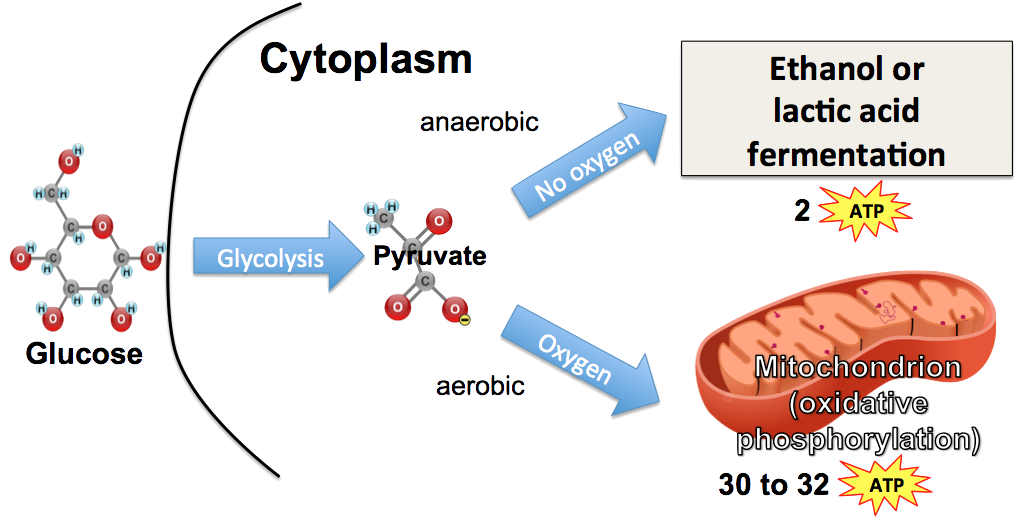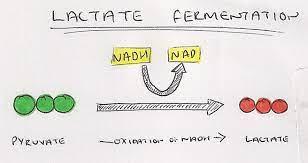Chapters
In this article, we will discuss anaerobic respiration in detail. So, let us get started.

Respiration
Respiration refers to the process that occurs in living cells and releases energy that is stored in organic molecules like glucose.
During respiration, energy is released to synthesize ATP molecules which can be employed as a quick energy source. There are two types of respiration:
- Aerobic respiration
- Anaerobic respiration
First, let us discuss aerobic respiration and its four stages.
Aerobic Respiration
Aerobic respiration is a type of respiration that occurs in the presence of oxygen. This kind of respiration helps to produce cellular energy.
The four stages of aerobic respiration are explained below:
- Glycolysis: It occurs in the cytoplasm of the cell and is phosphorylation and splitting of glucose.
- Link reaction: It occurs in the matrix of mitochondria and refers to the decarboxylation and dehydrogenation of pyruvate.
- The Kerbs cycle: It is the cyclical pathway with reactions controlled by the enzymes. It also occurs in the matrix of the mitochondria.
- Oxidative phosphorylation: It refers to the production of ATP through the oxidation of hydrogen atoms. It takes place in the inner membrane of the mitochondria.
In the next sections of the article, we will discuss anaerobic respiration in detail.
Anaerobic Respiration
Anaerobic respiration is a type of respiration that takes place in the absence of oxygen and releases less energy, but more quickly as compared to aerobic respiration. In microorganisms, anaerobic respiration is referred to as fermentation.
There are many consequences of insufficient oxygen for respiration:
- From the electron transport chain, there is no final electron acceptor
- The electron transport chain stops working
- No more ATP is generated through oxidative phosphorylation
- The electron carries do not oxidize reduces FAD and NAD
- The Kerbs cycle ceases.
However, cells can still produce some ATP in low oxygen conditions via anaerobic respiration.
In the next section, we will discuss anaerobic respiration in eukaryotes.
Anaerobic Respiration in Eukaryotes
There was no oxygen when life began on this planet. In the absence of oxygen, aerobic respiration was impossible. In anaerobic respiration, there is a net production of two molecules of ATP per glucose molecule. Anaerobic respiration in eukaryotic cells is now employed as an emergency measure to keep the important processes running.
Based on oxygen dependence, organisms are divided into the following categories:
- Obligate aerobes: These organisms can only synthesize ATP when oxygen is present.
- Facultative anaerobes: These organisms can synthesize ATP through aerobic respiration; however, they can turn to anaerobic respiration when needed. An example of such an organism is yeast.
- Obligate anaerobes: These organisms cannot survive if oxygen is present.

Fermentation
It refers to the process which does not use oxygen or an electron transport chain to break down organic compounds into smaller inorganic compounds. This process produces a small amount of ATP because it breaks down way less glucose as compared to aerobic respiration.
In the absence of oxygen, the synthesis of ATP by chemiosmosis comes to an end to accept electrons and protons at the end of oxidative phosphorylation.
NADH and FADH2 are not oxidized after the flow of electrons stops because there is no place where electrons can go. It means that FAD and NAD cannot be generated again. It also means that the oxidation and decarboxylation of pyruvate and the Kerbs cycle come to an end as there are no coenzymes available to remove the hydrogen ions.
Lactate fermentation takes place in animal cells and produces lactate. On the other hand, alcoholic fermentation takes place in yeast and some cells in the plants. This type of fermentation produces ethanol and carbon dioxide.
Lactate Fermentation in Mammals
Pyruvate acts as a hydrogen acceptor that takes hydrogen ions from NADH which is catalyzed by the enzyme known as lactate dehydrogenase. Pyruvate is transformed into lactate, i.e. lactic acid, and NAD has generated again. Lactic acid is transformed back into glucose in the liver but oxygen is needed to complete the process. This is the main reason for the oxygen debt post-exercise. This can be employed to keep glycolysis running to enable a tiny amount of ATP synthesis.
Lactate fermentation cannot occur indefinitely due to the following reasons:
- The reduced ATP quantity would be sufficient to sustain important processes over time.
- A fall in pH caused due to the accumulation of lactic acid results in the denaturation of proteins. For instance, muscle fibres and respiratory enzymes would stop functioning.

Alcoholic Fermentation in Yeast and Plants
Alcoholic fermentation is an irreversible process, unlike lactate fermentation. Pyruvate is transformed into ethanal through decarboxylation. After that, ethanal accepts a hydrogen atom from NADH to produce ethanol. This process generates NAD again and enables the continuation of glycolysis.
Alcoholic fermentation can take place indefinitely in the absence of oxygen because it is a long-term process. However, a toxic waste product to the yeast cell known as ethanol can kill them if it accumulates to more than 15 percent.
Adaptations of Living Organisms to Low Oxygen Environments
Different organisms have adapted themselves to low oxygen environments.
Bacterial Adaptations
As a final electron acceptor, various bacterial groups have evolved to employ nitrate ions, sulfate ions, or carbon dioxide as a final electron acceptor in environments where the concentration of oxygen is low. These adaptations enable them to live in aerobic conditions.
One such example of this kind of bacteria is methanogens. Methanogens refer to anaerobic bacteria which is found in the digestive system of ruminants like cows. Carbon dioxide is the final acceptor of the electron in the methanogens respiratory pathway
Adaptations in Mammals
Marine mammals that dive for an extended period of time have a wide range of adaptations that allow them to survive when extra oxygen is not available. Mammals are adapted in three ways:
Biochemical Adaptations
Greater concentrations of myoglobin and haemoglobin maximize the storage of oxygen in muscles utilized for swimming and thus delaying the onset of anaerobic respiration.
They also develop a greater tolerance for carbon dioxide and lactic acid.
Physiological Adaptations
They have a modified circulatory system that enables them to perform peripheral vasoconstriction. This helps them to prioritize the flow of blood to the brain, heart, and muscles for efficient use of oxygen. This can also slow the heart by 85% leading to bradycardia (minimizing the energy demand).
They can exchange 85-95% of the air in their lungs to enable a lot more intake of oxygen in every breath.
Physical Adaptations
Body streamlining minimizes water resistance leading to energy conservation during swimming. Fin-shaped limbs enable a lot more efficiency in propulsion, also leading to energy conservation during swimming.













Keep on teaching us,you are excellent teachers
This is great
Thanks a lot for this book,it really helped me a lot
It’s useful to me
Thanks a lot for your Better book!
It’s a perfect article, go ahead